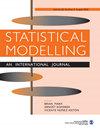半连续纵向数据的两部分分位数回归模型:有限混合方法
IF 1.2
4区 数学
Q2 STATISTICS & PROBABILITY
引用次数: 3
摘要
本文为半连续纵向数据建立了一个由两部分组成的有限混合分位数回归模型。所提出的方法允许影响二元响应变量模型的异质性来源也影响积极结果的分布。正如分位数回归文献中常见的那样,对模型参数的估计和推断是基于不对称拉普拉斯分布的。最大似然估计是通过EM算法获得的,而不需要对随机效应分布进行参数假设。此外,还提出了EM算法的惩罚版本来解决变量选择问题。将所提出的统计方法应用于著名的兰德健康保险实验数据集,进一步深入了解了其实证行为。本文章由计算机程序翻译,如有差异,请以英文原文为准。
Two-part quantile regression models for semi-continuous longitudinal data: A finite mixture approach
This article develops a two-part finite mixture quantile regression model for semi-continuous longitudinal data. The proposed methodology allows heterogeneity sources that influence the model for the binary response variable to also influence the distribution of the positive outcomes. As is common in the quantile regression literature, estimation and inference on the model parameters are based on the asymmetric Laplace distribution. Maximum likelihood estimates are obtained through the EM algorithm without parametric assumptions on the random effects distribution. In addition, a penalized version of the EM algorithm is presented to tackle the problem of variable selection. The proposed statistical method is applied to the well-known RAND Health Insurance Experiment dataset which gives further insights on its empirical behaviour.
求助全文
通过发布文献求助,成功后即可免费获取论文全文。
去求助
来源期刊

Statistical Modelling
数学-统计学与概率论
CiteScore
2.20
自引率
0.00%
发文量
16
审稿时长
>12 weeks
期刊介绍:
The primary aim of the journal is to publish original and high-quality articles that recognize statistical modelling as the general framework for the application of statistical ideas. Submissions must reflect important developments, extensions, and applications in statistical modelling. The journal also encourages submissions that describe scientifically interesting, complex or novel statistical modelling aspects from a wide diversity of disciplines, and submissions that embrace the diversity of applied statistical modelling.
 求助内容:
求助内容: 应助结果提醒方式:
应助结果提醒方式:


